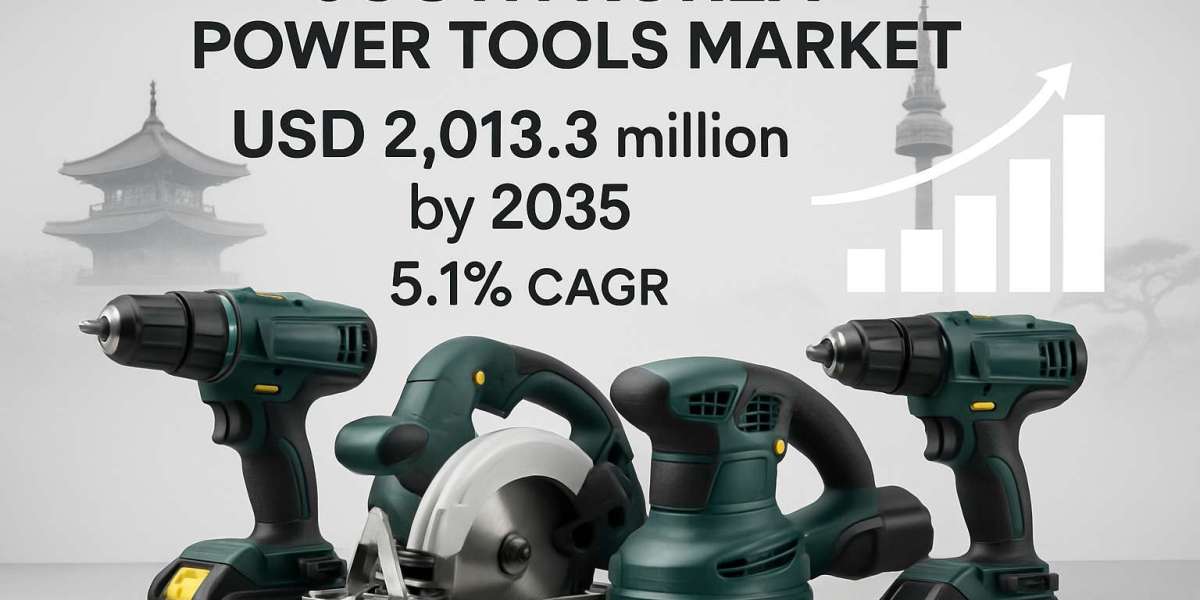The South Korean power tools market is projected to grow from USD 1,209.9 million in 2025 to approximately USD 2,013.3 million by 2035, registering a compound annual growth rate (CAGR) of 5.1% over the forecast period.
Strong domestic manufacturing capabilities, government initiatives for smart factories, and growing consumer preference for cordless and energy-efficient tools are contributing significantly to this growth. Additionally, South Korea's robust e-commerce landscape and digital infrastructure have facilitated the rapid adoption of power tools across consumer and professional segments alike.
Uncover Market Opportunities: Access a Sample Report Now!
Key Industry Highlights
- Rise in Cordless Tool Adoption:
South Korean consumers and industrial users are increasingly shifting toward cordless power tools powered by advanced lithium-ion batteries. This segment is expected to show the highest growth rate, particularly in urban residential and light construction applications. - Smart Power Tools & IoT Integration:
Driven by South Korea’s reputation as a tech-forward nation, power tool manufacturers are rapidly integrating smart features such as sensor diagnostics, performance monitoring, and Bluetooth connectivity, especially in tools used in manufacturing and precision industries. - DIY Culture and Home Renovations:
The surge in DIY activities among younger consumers, especially amid remote working trends, has led to increased sales of compact, user-friendly tools like drills, saws, and sanders through online retail platforms. - Emphasis on Safety & Ergonomics:
South Korean buyers are increasingly seeking tools that enhance safety and comfort. Features such as anti-vibration handles, low-noise motors, and smart shut-off mechanisms are becoming standard in premium models.
Collaboration between Small Market Players to Strengthen Product Portfolio
In South Korea, small and medium-sized enterprises (SMEs) are actively partnering with battery manufacturers, design firms, and logistics providers to improve their competitive edge. These collaborations enable local players to develop niche products tailored to specific industrial needs, especially in automotive manufacturing, shipbuilding, and electronics.
SMEs are also focusing on co-branding and joint ventures with international brands to expand their reach. For example, several domestic toolmakers are aligning with suppliers of robotic tool systems to enter the smart automation segment. These efforts help enhance product differentiation, reduce costs, and bridge technology gaps with global competitors.
Market Concentration
The South Korean power tools market exhibits moderate to high concentration, with major global players such as Bosch, Makita, Stanley Black & Decker, and Hilti holding significant market share, particularly in the professional-grade segment. These companies benefit from well-established distribution networks, consistent product innovation, and strong after-sales support.
However, local brands like KPT, Hanil, and Keyang are increasingly competing in the price-sensitive and semi-professional categories by offering cost-effective, durable tools suited for South Korean work environments. These local players are also expanding their product lines with features that appeal to domestic safety standards and energy regulations.
Country-wise Insights
South Korea’s power tools market is largely urban-centric, with regions such as Seoul, Incheon, and Busan leading in sales volumes due to concentrated construction activities and manufacturing hubs. The Gyeonggi-do province, with its dense population and mix of residential and industrial zones, is also emerging as a hotspot for power tool consumption.
The southern industrial belt, including Ulsan and Gwangyang, contributes significantly to demand from shipbuilding and automotive manufacturing sectors, while the Jeolla and Gangwon regions are witnessing growing demand due to rural infrastructure development and agriculture-based mechanization.
Cmpetition Outlook
Global power tool manufacturers dominate the premium and professional segments in South Korea. Brands like Bosch and Makita leverage their innovation pipelines, focusing on cordless platforms, modular systems, and digital integration. Bosch, in particular, continues to gain traction through localized marketing strategies and training initiatives.
Hilti and DeWalt serve niche segments including heavy construction and HVAC, while Ryobi and Milwaukee target semi-professional and DIY users with a focus on ergonomics and tool kits.
Domestic players such as Keyang Power Tools, KPT, and Hanil Electric are gaining momentum in the mid-tier market by offering price-competitive alternatives with solid reliability and region-specific customizations. They are also increasing R&D investment and product localization to expand their share in both B2B and B2C channels.
Online platforms like Coupang, Gmarket, and Naver Shopping have emerged as major sales channels, especially for DIY and compact tools, offering tools bundled with accessories, maintenance packages, and competitive discounts.
Key Players
- Bosch
- Makita
- DeWalt
- Hilti
- Keyang Electric Machinery
- Hyundai Power Tools
- Black & Decker
- Ryobi
- Stanley
- Makita Korea
Key Segmentation
By Product Type:
In terms of Products, the industry is divided into Drilling Tool, Fastening Tool, Heat Gun, Angle Grinder, Chain Saw, Orbital Sander, Jigsaw, Impact Wrench, and Circular Saw.
By Technology:
In terms of Technology, the industry is segregated into Electric and Pneumatic Tools. The Electric segment has been further segregated into Corded, and Cordless. Then Cordless segment is segregated into Li-ion Battery, Lead Acid Battery, and Others (Ni-Cd, Ni-MH).
By Sales Channel:
In terms of Sales Channel, the industry is divided into Online and Offline.
By Application:
In terms of Application, the industry is segregated into Manufacturing, MRO Services, DIY, and Construction.



